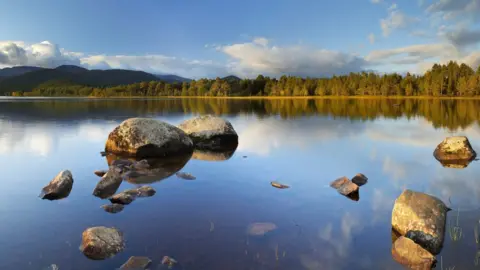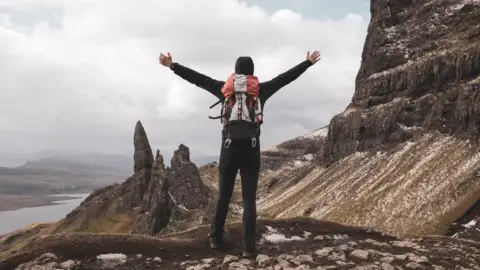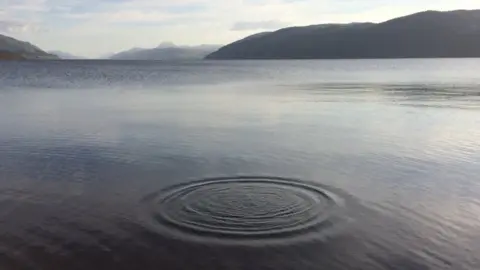Slow awakening of Highlands tourism industry from lockdown
 Getty Images
Getty ImagesTourism is the biggest industry in the Highlands and the thousands of people whose livelihoods depend on it have been eagerly awaiting the safe return of visitors.
Before the coronavirus pandemic, the region's six million annual visitors were worth an estimated £1.2bn and supported 20,000 jobs.
In the Highlands, the relaxation of lockdown restrictions last week - after more than three months - has brought a mini boom in visitors for some places, and an unexpected lack of them in others.
The Cairngorms has been among the hotspots.
Tamasina Cassidy, who runs The Rowan Tree Country Hotel near Aviemore, said the wide open spaces the area offered had been one of the attractions for visitors.
"It's lovely to have people back and having a good time," she said.
"We have a lot of people up on holiday, mostly from Glasgow and Edinburgh, and a few from further afield.
"There are a few people who are a little nervous but we've got plenty of space for them."
'Business is good'
Mrs Cassidy said her hotel had benefited from last-minute bookings.
"Business is very good at the moment," she said.
In Aviemore, Jim Halloran's Dunroamin B&B has bookings through to early autumn.
He said: "We are pretty much booked up for all of this week and bookings are coming in on a daily basis as far forward as October."
Mr Halloran added: "I think the powers that be have got it absolutely right in holding back just that little bit longer just to make sure that we were properly prepared."
But the popularity of the Cairngorms has brought one unpleasant challenge.
Human waste
A small minority of people have been blamed for littering problems at beauty spots such as Linn of Dee, Loch Muick and Muir of Dinnet in Aberdeenshire and Loch Morlich near Aviemore.
"Sadly we are seeing a small but damaging number of people irresponsibly camping outdoors - and to be blunt the problems are the litter, the fires and human waste left behind," said Pete Crane, head of visitor services at the Cairngorms National Park Authority (CNPA).
He said the park authority was working hard with communities, police and the local authority to change this "messy activity".
Geva Blackett, a member of CNPA's board, said: "We really welcome visitors out here but we've had more than we can cope with. We haven't got the infrastructure to cope with them in many ways.
"Not all the public conveniences are open and people, I'm afraid, have been behaving quite irresponsibly, in some cases leaving their own excrement lying around along with paper and personal hygiene items.
"It is not only disgusting for people to have to go and clear up it is also quite dangerous for wildlife."
 Getty Images
Getty ImagesOver on Skye, tourism businesses had been anticipating a positive start to the return of visitors.
Before Covid-19, the number of tourists to the island had increased to an estimated 500,000 a year.
"We got ready to open last Wednesday and thought we would be really busy and there would be a bounce of business, but it hasn't really been the case," said Anne Gracie Gunn, of the Skeabost House Hotel.
"The business has just trickled through."
Holiday nerves
Bookings have been about 25% of what the hotel would normally get in July.
Mrs Gunn said: "We usually enjoy 100% occupancy from the end of March to the 3 October.
"It is the lack of the American market particularly."
She also said some UK visitors still seemed nervous about taking holidays, adding that from her conversations with others in the same business across Scotland the return of visitors had been "far slower" than expected.
On the other side of the Highlands in Nairn on the Moray Firth coast, businesses have been working on a new initiative to attract visitors.
'Businesses are struggling'
Under the banner Scotland's Highland Playground, Nairn Business Improvement District has been busy promoting what the town and surrounding area has to offer - including beaches, golf courses and restaurants.
Chairman Michael Boylan said: "Nairn is predominantly a tourist town, so there is not a business in the town that has not been adversely affected by the impact of this worldwide situation.
"Our local economy relies on people wanting to travel and stay here and enjoy what we have to offer and as that has not been an option, businesses are struggling."
"However, we have always been looking forward. Staycations are likely to become more of a thing and Nairn really does have something for everyone."
 Andy Gray
Andy GrayMeanwhile, in Lochaber operators and staff at the Nevis Range Mountain Experience, on the slopes of the mountain Aonach Mor near Fort William, have also been grafting away to get visitors back.
The resort offers mountain biking in summer and snowsports in winter and spring.
The site closed in late March as part of efforts to prevent the spread of coronavirus.
"Coronavirus has brought nothing but cruel ironies for Nevis Range," said chief executive Chris O'Brien.
"Shortly after we closed we had six weeks of the best skiing conditions in about a decade. Then after that we had another six weeks of glorious weather.
"There were days when I would look up at the mountain and go 'Aww come on'."
Typically, between 1 June and the end of September Nevis Range has about 100,000 visitors.
The annual Fort William Mountain Bike World Cup brings in 20,000 of those visitors, while 40,000 of them are tourists who come by coach. About 15,000 of the resort's visitors are from overseas.
In the past week, the site would normally have seen 8,000 visitors but there were just 2,000.
'Record bike sales'
Mr O'Brien said: "Over the last week what has been very apparent is that we haven't had those international visitors and coach visitors.
"But what has been really positive is that we have seen more bikes than we normally would. The lockdown saw record bike sales and there are lots of people eager to get on to our downhill trails."
The weekend before Nevis Range reopened, 50 volunteers worked on getting its trails ready.
For now, the resort is open just five days a week. Fifty-nine people are employed by the site, with some still furloughed or on flexible furlough and working two days a week while about 12 are working from home.
"Sadly we had to make 23 people redundant," Mr O'Brien said.
For those working on site a new hygiene regime is of paramount importance.
There are 45 hand sanitising points across the site and its gondola cabins are fog sanitised every night as part of the enhanced cleaning protocol.
Mr O'Brien said the regime could easily be adapted for the winter season in line with any future government guidance.

From the dizzy heights of Lochaber's mountains to the murky depths of Loch Ness, where its famous waters and monster legend help to bring hundreds of thousands of visitors a year - Urquhart Castle on the loch's shore can draw more than 500,000 alone - to the surrounding area.
Michael Golding, chief executive of Visit Inverness Loch Ness, said the destination was showing "promising signs of progressing on the road to recovery".
'Strongest asset'
Daily visits to the tourism organisation's website have been increasing and many self-catering business are fully booked for the remainder of the year.
Mr Golding said: "The tourism and hospitality sector has been the greatest loss to the Highland economy due to the pandemic.
"The sector is therefore our strongest asset for a recovery in communities across the destination."
And what about the loch's famous monster?
"There have been no Nessie sightings reported over the last two weeks," said Gary Campbell, keeper of The Official Loch Ness Monster Sightings Register.
"Maybe she's still social distancing."
